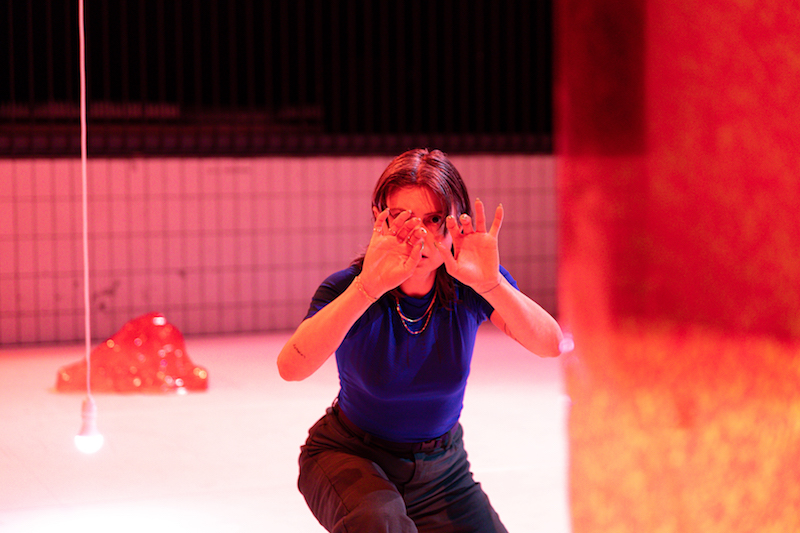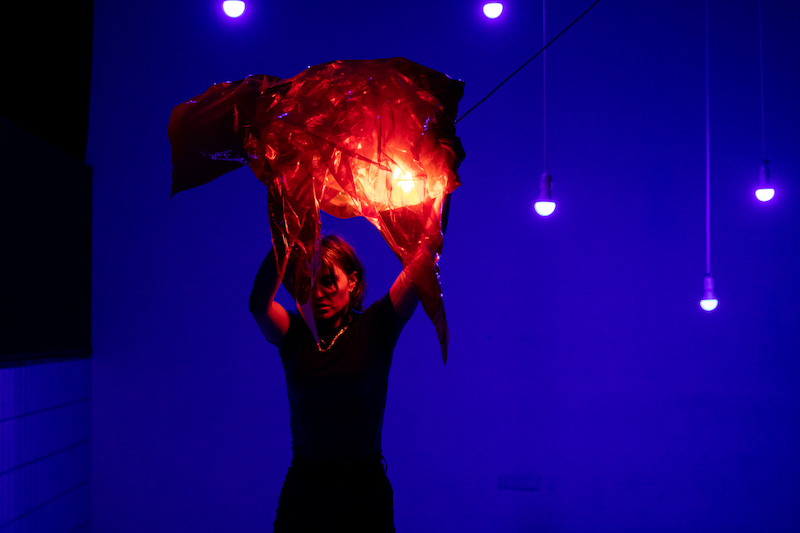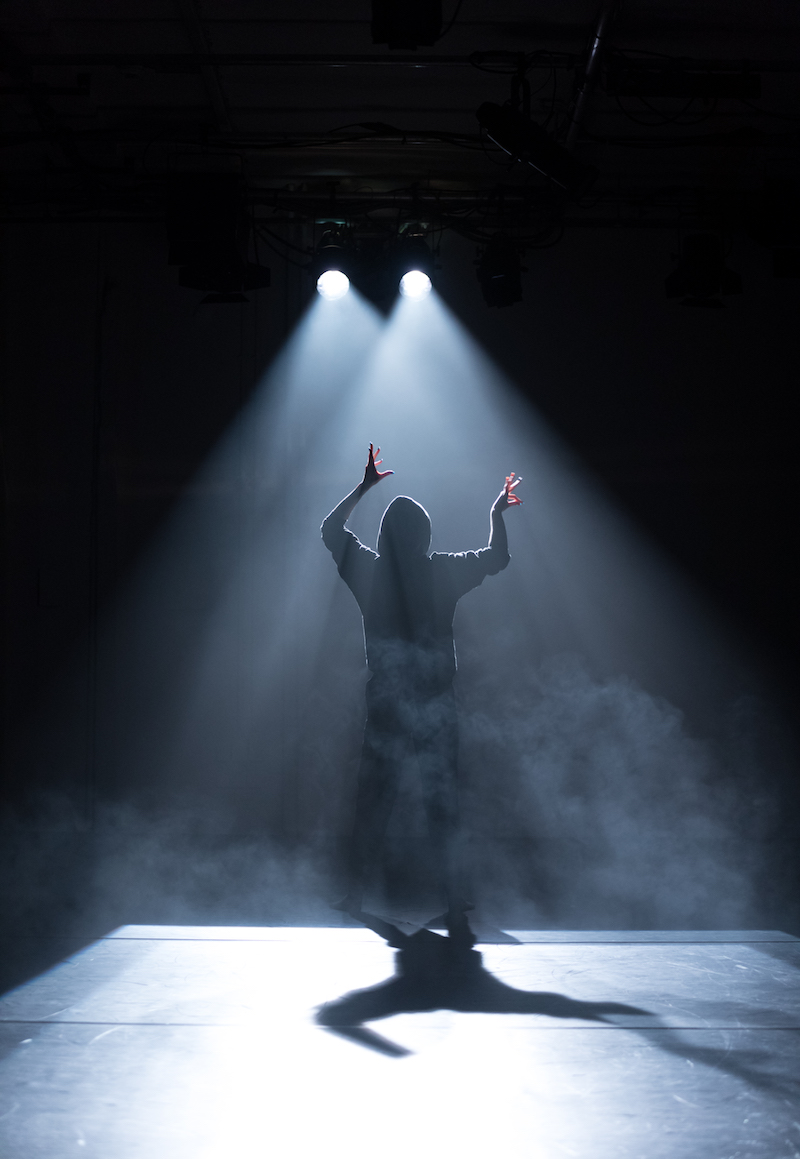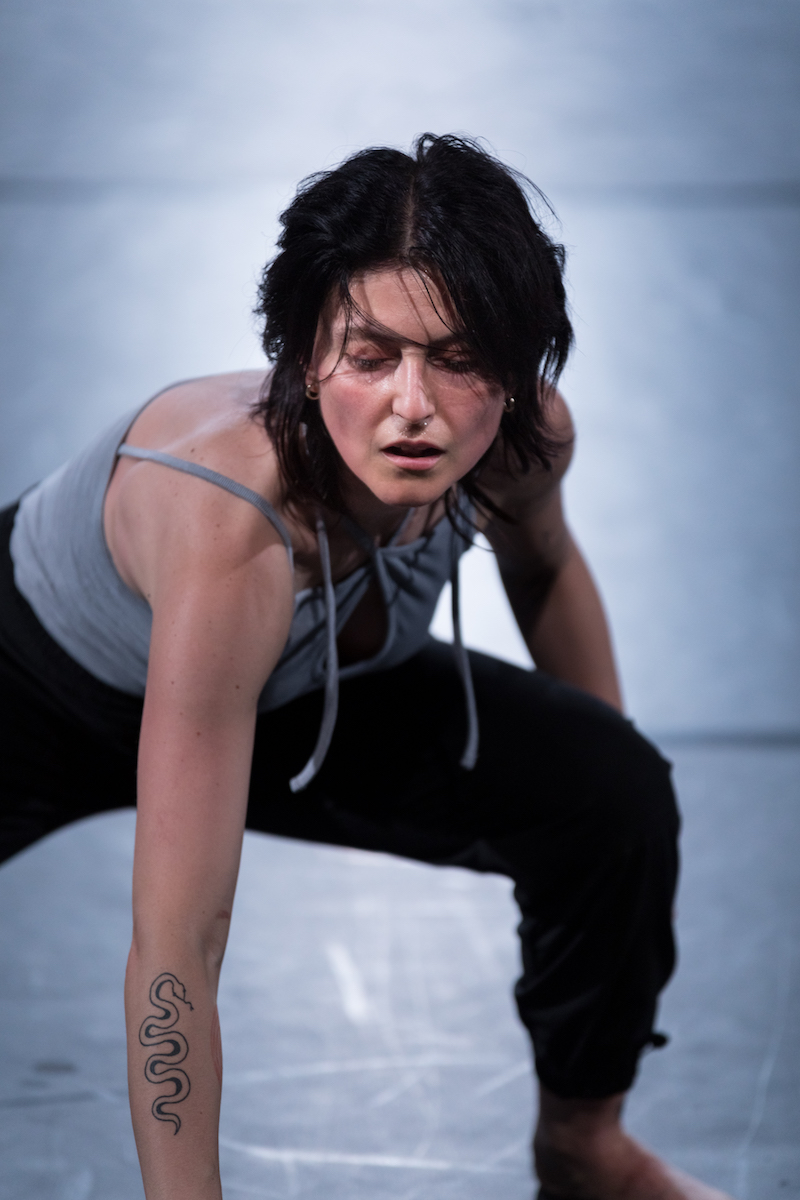by Cristina Ramos // Oct. 29, 2024
This article is part of our feature topic Accessibility.
Rita Mazza is a Berlin-based performance artist, artistic director and Sign Language choreographer in visual sign performances for Deaf and hearing audiences. Their recent research revolves around ways to enrich Sign Language by combining it with dance movements, thus expanding the modes of expression of the Deaf community in a new form of poetry. Working with body, rhythm and light, their pieces give access a multi-dimensional meaning, translating language into visual and sensual forms. We spoke with Mazza about their recent pieces, such as ‘Dandelion II’ (2020), their first solo work co-produced with Making a Difference Berlin, and ‘The Voice,’ which premiered as part of Tanz im August this past summer.

Rita Mazza: ‘Matters of Rhythm’ // Photo by Mayra Wallraff
Cristina Ramos: You grew up with Italian Sign Language as your first language. What’s the role of accessibility in your practice? How do you work with it in relation to an audience?
Rita Mazza: Yes, I grew up with Sign Language. However, in my projects, I usually work with a completely hearing team. There are some hearing colleagues who are able to sign. This is great, because it’s the fastest way to communicate, it’s direct and it brings us closer. But the great majority of hearing colleagues have no Sign Language skills. To ensure communication and accessibility within the team, we work with interpreters. This is not an optimal solution, though. Over sustained periods of time, it is exhausting, as it is always a translation and an indirect form of communication. In addition to working with interpreters, everyone who collaborates with me must be able to adapt very flexibly to different forms of communication. If no interpreters are available, they must be able to fall back automatically on written language, communicate with more body language, gestures and facial expressions. In general, showing a fundamental willingness to learn the basics of sign language is very much appreciated. It is precisely this flexibility and willingness that makes collaboration successful, when people who are used to working in spoken language contexts join my projects. Just as I enter their hearing world.
In terms of the audience, I try to integrate as many accessibility tools as possible. For example, I work with audio description, my performances are Relaxed Performances, and pre-show access is offered. I am still learning how to work best with these elements. My performances are inherently visual, so I invite the audience into our world where they perceive everything visually. In my most recent piece ‘The Voice,’ I decided to include subtitles. This tool typically creates access for us Deaf people. But, in the piece, the same access is created for hearing and Deaf audiences. The subtitles contain my thoughts and feelings that came up during the rehearsal process, in which I explored my relation to my voice and especially human sounds. Thus, the subtitles are to be understood as an accessibility tool, but at the same time they bring the piece closer to the audience on a content level. I also worked with a Sign Language interpreter on stage who is a CODA (Child Of Deaf Adults). As sounds produced by me are a central element in this piece, they were described for Deaf people.

Rita Mazza: ‘Matters of Rhythm’ // Photo by Mayra Wallraff
CR: In your pieces you are often interested in representing ideas related to sign language through the means of dance, gesture and choreography, thus bringing in another level of attention to language. When thinking about access, it seems urgent to start by critiquing the societal normalisation of the voice. What kind of artistic means do you employ in your work to express or escape this?
RM: In general, I aim to offer the audience as many different visual elements as possible. I work with different forms, including, for example, visual sign choreographies, some of which include signs. This means that people in the audience who understand Sign Language actually have a slight advantage. The performance ‘Dandelion II,’ for example, was exclusively visual without any translations or acoustic elements. People in the audience with Sign Language skills could possibly recognize individual signs in some places, but the performance as a whole remained very abstract even for them, as the individual signs were manipulated and altered in a way that creates doubt and leaves plenty of room for interpretation. I worked on the basis of signed texts, which were, however, decomposed. I then altered single signs, expanded them or combined them with another movement or point of execution. In this way, the meaningful elements were set aside and only the forms were worked with and abstracted in order to create dance forms and choreographies. For the audience without Sign Language skills, it was hardly possible to identify these subtle nuances of Sign Language. Nevertheless, the piece as a whole conveys information and an understanding on an emotional level for everyone in the audience, as the choreography, body language and facial expressions convey a great deal and allow individual interpretations.
In the context of ‘Dandelion II,’ I didn’t really focus on accessibility for different audiences, but rather on Sign Language and the question of how abstract forms can be brought on stage and integrated into choreography, dance and movement, by using Sign Language as a starting point. However, I recognize a difference in the relationship between the audience and me depending on the degree of accessibility that is offered. If access and therefore understanding is given to a certain extent, audiences feel closer to me and the piece. Meanwhile, a greater distance is created between me and the audience if the piece does not allow access. Accordingly, my two pieces ‘Dandelion II’ and ‘The Voice’ were very different, so that in the latter the audience could follow me because they could understand. With ‘Dandelion II’ it felt very far away. It’s interesting to see what an important role and influence the aspect of accessibility has on the respective pieces.

Rita Mazza: ‘Dandelion II,’ 2020 // Photo by Mayra Wallraff
CR: Disabled people are often pushed to dissociate from themselves, from their bodies, in order to fit the logic of an ableist society. Trusting the body and listening to the body are invitations that one finds in your performances as a way to access one’s own agency. How does the act of listening, in its various meanings, manifest in your practice?
RM: For me, accessibility is also always linked to time resources. It requires organisation and you have to be open to the individual needs within the respective process. Access cannot succeed in the desired form without time or it creates pressure and stress for those involved. For this reason, time is a key element for me. With sufficient time and organisation, you can adapt to individual needs. In my artistic practice, I work in such a way that a lot of time is available for this. Of course, this also comes with difficulties, as it sometimes limits the time available for artistic and creative processes, but I try as much as possible. It’s often the little things that can make a big difference. I would like to illustrate this with an example: as part of my projects, every rehearsal starts with a joint check-in. All team members present can share with the group how they feel and what they need for this day of work together. This practice facilitates the exchange of individual needs within the team. We decide how to organise the day based on this. I consider this to be a very good practice. But even this requires time, which we take at the beginning of every day.

Rita Mazza: ‘Dandelion II,’ 2020 // Photo by Mayra Wallraff
CR: Alice Wong, a writer and activist referenced in thinking beyond the frame of a non-disabled world, beautifully subverts the meaning of intimacy from disabled perspectives. What does intimacy mean to you in your practice?
RM: Personally, I have come to understand that I have needs in professional contexts on two different levels: on the surface, my needs with regard to communication are met by the use of accessibility tools such as Sign Language, interpreters, communication through written language or facial expressions and gestures. These tools allow me to be in control. Apart from that, there are also in-between situations, such as breaks or emergency situations. In these moments, there is an invisible need within me. It is an inner feeling and relates to the need for seeing eye-to-eye and having equal access to communication. As long as this is understood within my team or my environment, without me having to explain it, I can build trust. For example, during breaks, when there are no interpreters present, it is usually the case that the hearing people automatically communicate in spoken language. I then find myself in a position where I am not on an equal footing. It would be great if people are aware of this situation and make sure that in these cases there is also a form of translation for me that makes the content and communication accessible. I would also like to be equally in control and receive the information in emergency situations. If the people around me understand this, are aware of it and behave according to my needs, it feels intimate and trusting.























